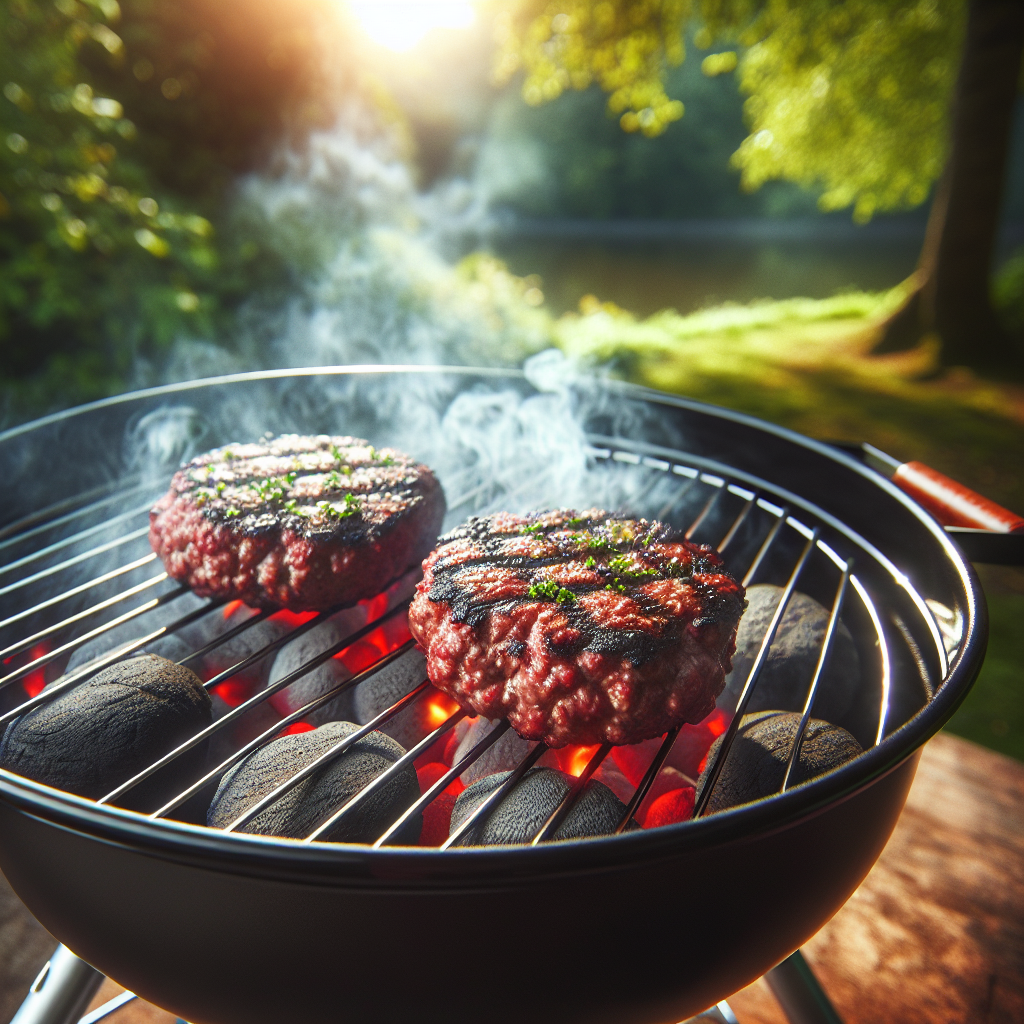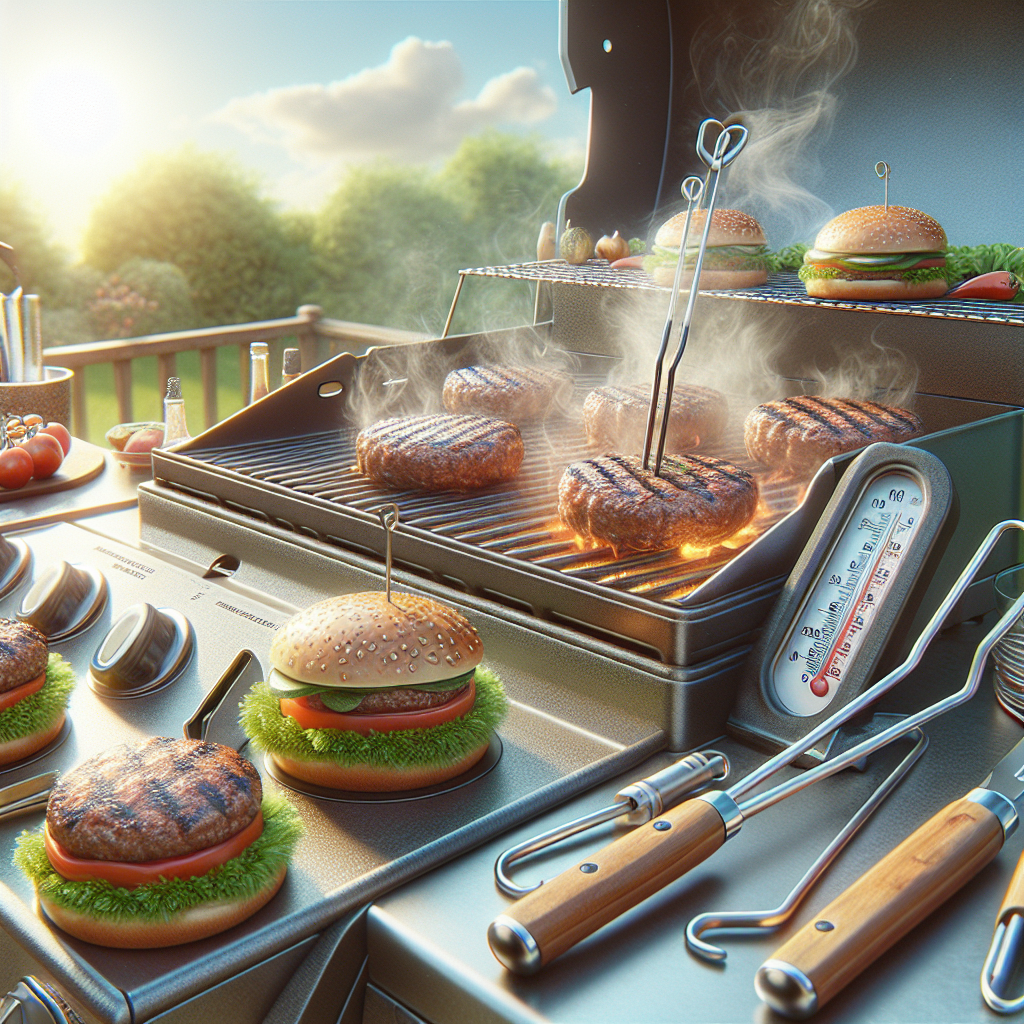You want to grill the perfect burger, but you’re not quite sure what temperature is best. Well, fear not, because in this article we’ve got you covered! We’ll give you all the juicy details on the ideal temperature for grilling mouthwatering burgers. Whether you prefer them medium-rare or well-done, we’ve got the tips and tricks to help you achieve burger perfection every time. So grab your apron and get ready to become a burger-grilling pro!
Choosing the Right Temperature
Grilling burgers is a beloved pastime for many, but getting the temperature just right can make all the difference between a juicy, flavorful burger and a dry, overcooked one. There are several factors to consider when choosing the right temperature, so let’s delve into them.
Factors to Consider
The type of meat you’re using, the desired level of doneness, and the thickness of your burgers are all important factors to consider when determining the right temperature for grilling burgers. Different meats and burger styles will require different cooking temperatures to achieve optimal results.
Understanding Internal Temperatures
To ensure that your burgers are cooked to perfection, it’s essential to understand the internal temperature guidelines for different burger styles. For classic beef burgers, a medium-rare burger should have an internal temperature of around 130-135°F, while a well-done burger should reach 160°F. Turkey burgers, on the other hand, should reach a minimum internal temperature of 165°F to ensure food safety. Veggie burgers typically have a lower required internal temperature due to the absence of meat.
Preheating the Grill
Before you even start grilling, it’s crucial to preheat your grill properly. This step ensures that your burgers cook evenly and develop that delicious sear on the outside.
Various Types of Grills
There are several types of grills to choose from, including gas, charcoal, and electric grills. Gas grills offer convenience and precise temperature control, while charcoal grills provide that distinct smoky flavor. Electric grills are a great option for indoor grilling.
Preheating Instructions
Regardless of the type of grill you’re using, preheating is a necessary step. For gas grills, preheat on high for 10-15 minutes with the lid closed. With charcoal grills, light the charcoal and let it burn until covered with gray ash, usually about 20-30 minutes. For electric grills, follow the manufacturer’s instructions for preheating.

Direct vs. Indirect Cooking
Understanding the difference between direct and indirect cooking methods can significantly impact the outcome of your burgers.
Benefits of Direct Cooking
Direct cooking involves placing the burgers directly over the heat source. This method is ideal for burgers that require a shorter cooking time or for those who prefer a more seared exterior. Direct cooking is perfect for achieving that classic grill mark and a juicy result.
Benefits of Indirect Cooking
Indirect cooking, on the other hand, involves placing the burgers to the side of the heat source, allowing them to cook more slowly and evenly. This method is ideal for thicker burgers or those that require a longer cooking time. Indirect cooking helps prevent the outside from burning while ensuring that the inside reaches the desired level of doneness.
Temperature Guidelines for Different Burger Styles
Different burger styles require different temperature guidelines to ensure optimal flavor and safety.
Classic Beef Burgers
For classic beef burgers, medium-rare is often preferred by many burger enthusiasts. To achieve this, grill the burgers at a temperature of around 375-400°F for 4-5 minutes per side, or until an internal temperature of 130-135°F is reached. For those who prefer a well-done burger, grill at the same temperature for about 6-7 minutes per side, or until the internal temperature reaches 160°F.
Turkey Burgers
Turkey burgers require a higher internal temperature compared to beef burgers to ensure they are safe to eat. Grill turkey burgers at 375-400°F for about 6-8 minutes per side, or until the internal temperature reaches 165°F. This higher temperature ensures that any potential bacteria is eliminated, guaranteeing food safety.
Veggie Burgers
Veggie burgers are a popular option for vegetarians and those looking for a meatless alternative. While the cooking time may vary depending on the brand or homemade recipe, veggie burgers typically require a lower cooking temperature than meat-based burgers. Grill at a temperature of around 350-375°F and follow the package instructions or recipe guidelines for specific cooking times.

Determining Burger Doneness
Determining the doneness of your burgers is a crucial step to ensure that they are cooked to your liking.
Using a Meat Thermometer
Using a meat thermometer is the most accurate way to determine the internal temperature of your burgers. Insert the meat thermometer into the thickest part of the burger, avoiding contact with the bone or grill grates. Refer to the temperature guidelines mentioned earlier to determine the desired level of doneness.
Visual Cues
For those who prefer not to use a meat thermometer, there are visual cues that can help determine the doneness of your burgers. For medium-rare, the burgers should have a warm red center. For medium, the center should be slightly pink, and for well-done, there should be no pinkness, with the juices running clear. Use these visual cues in combination with cooking times to ensure your burgers are cooked to perfection.
Safety Considerations
When it comes to grilling burgers, safety should always be a top priority.
Avoiding Undercooked Burgers
Undercooked burgers can pose a risk of foodborne illnesses. To ensure that your burgers are safe to eat, always cook ground meats, including burgers, to a minimum internal temperature of 160°F. This kills any potential bacteria, ensuring that your burgers are safe for consumption.
Preventing Overcooked Burgers
On the other end of the spectrum, overcooked burgers can result in a dry and less enjoyable eating experience. To prevent overcooking, monitor the internal temperature of your burgers using a meat thermometer and remove them from the grill as soon as they reach the desired level of doneness.
Tips for Juicy and Flavorful Burgers
Achieving juicy and flavorful burgers goes beyond just choosing the right temperature. Here are some additional tips to elevate your burger game.
Choosing the Right Meat
Start with high-quality meat to ensure a juicy and flavorful burger. Opt for ground beef with a higher fat content, such as 80/20 or 85/15. The fat adds moisture and flavor to the burger, resulting in a more enjoyable eating experience. If using leaner meats like turkey or chicken, consider adding extra moisture (such as breadcrumbs or finely chopped onions) to enhance the juiciness.
Adding Extra Moisture
To further enhance juiciness, consider adding additional moisture to your burgers. Mix in ingredients like Worcestershire sauce, soy sauce, or even a tablespoon of mayonnaise into the meat mixture before forming the patties. These ingredients not only add moisture but also contribute to the overall flavor profile of your burgers.
Avoiding Common Grilling Mistakes
Even with the right temperature and juicy meat, it’s easy to make some common grilling mistakes that can affect the outcome of your burgers.
Cooking Burgers Straight from the Fridge
Avoid the mistake of cooking burgers straight from the fridge. Let the burgers come to room temperature for about 20-30 minutes before grilling. This allows the burgers to cook more evenly and helps prevent the exterior from burning while the center remains undercooked.
Pressing the Burgers
Resist the temptation to press down on your burgers while cooking. Pressing the burgers will release valuable juices, resulting in a drier end product. Instead, let the burgers cook undisturbed and allow the natural juices to stay within the patties, keeping them moist and flavorful.
Resting and Serving Burgers
Once your burgers are cooked to perfection, it’s essential to let them rest before serving.
Resting Period
Allow your burgers to rest for a few minutes after removing them from the grill. This resting period allows the juices to redistribute throughout the meat, ensuring that each bite is juicy and flavorful. Resting also helps the burgers retain heat, so they are still warm when served.
Serving Temperature
It’s important to serve your burgers at the correct temperature to maximize flavor and enjoyment. Serve beef burgers hot off the grill, while turkey or veggie burgers can be served slightly warmer but not piping hot. Accompany your burgers with your favorite toppings and buns, and enjoy your masterpiece.
Alternative Cooking Techniques
While grilling is the go-to method for cooking burgers, there are alternative techniques that can also yield delicious results.
Pan-Frying
If grilling is not an option, you can pan-fry your burgers on the stovetop. Heat a skillet or frying pan over medium-high heat and cook the burgers for about 4-5 minutes per side, or until the desired internal temperature is reached.
Oven-Baking
Oven-baking is another option for cooking burgers indoors. Preheat your oven to 375°F and place the burgers on a baking sheet lined with parchment paper. Bake in the oven for approximately 20-25 minutes, or until the internal temperature reaches the desired level of doneness.
Sous Vide
For those who want to achieve precise and consistent results, sous vide is a cooking technique worth exploring. Sous vide involves vacuum-sealing the burgers with seasonings and cooking them in a temperature-controlled water bath. Afterward, sear the burgers on high heat to develop a crust before serving.
In conclusion, choosing the right temperature is crucial for grilling delicious and perfectly cooked burgers. Consider the factors that affect temperature, understand internal temperatures, and familiarize yourself with different burger styles. Preheat your grill properly, determine whether direct or indirect cooking is best for your burgers, and use a meat thermometer or visual cues to determine doneness. Prioritize safety, follow tips for juicy and flavorful burgers, and avoid common grilling mistakes. Allow your burgers to rest before serving, and consider alternative cooking techniques for indoor cooking. With these guidelines in mind, you’re well on your way to grilling mouthwatering burgers that will impress your friends and family. Happy grilling!
